Horses and the History of the Circus
The history of the modern circus is deeply rooted in horsemanship. The first modern circuses, which took place during the 18th century, were primarily demonstrations of tricks performed on a horse, first by former soldiers who learned such skills during military training, and later by talented men and women trained from a young age to accomplish acrobatics and other feats atop a horse. In order to teach horses to perform tricks for the circus amphitheater, horsemen relied upon instruction from mentors and in books such as Dr. Sutherland’s System of Educating the Horse, with Rules for Teaching the Horse Some Forty Different Tricks or Feats. . . This 1861 text by Dr. G. H. Sutherland claims to be the first ever published on “Educating the Horse” (view in book here).
Horse trainers in Great Britain were considered humane in their work, and as London trainer Charles Montague wrote in his 1881 book, Recollections of an Equestrian Manager (in Simon, 2014, pp. 29-10): “The horse must first be brought to feel that you are his master—his superior; not through fear of your power; but on the contrary, through his experience that though you have the power, it is always accompanied by kindness. . .never with cruelty.” In America, Dr. Sutherland represented those using humane animal training practices, and in his text he stated that he was “convinced, by observations as well as experience, that we can successfully tame, subdue, and control the most wild and vicious horse by kindness alone. . .” (view in book here), and he proposed a training system that vehemently avoided “the use of the whip, drugs, or fetters. . .” (view in book here).
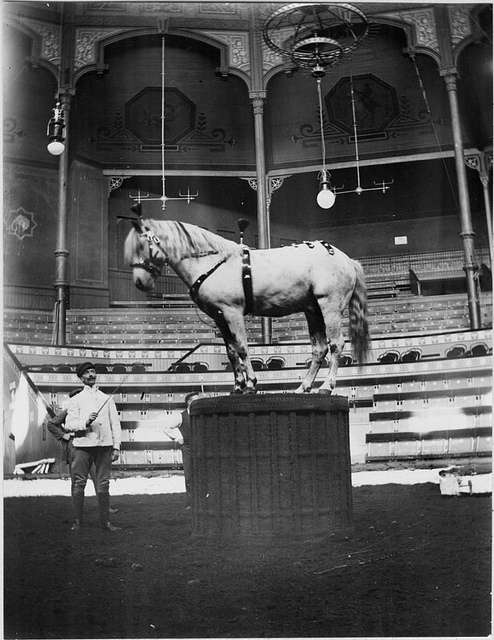 |
| Horse at the circus in Stockholm (1905) | Unknown Attribution |
Sutherland’s horse tricks are quite delightful, and include training the horse to remove the trainer’s “cap, coat and mittens” (view in book here). Other tricks include teaching the horse to stand up, lay down, knock on a door, say yes or no, fetch and retrieve objects, walk on hind legs, to unbuckle his own saddle and remove it, open and close doors, pump water, fire a pistol, tell his A, B, C’s, spell, read, and more amazing things! All of these tricks begin in the book here. When Philip Astley created the first modern circus in 1768 in London, he had his horse count, perform mind reading, and play dead. In addition, Astley, and later more performers he hired, would end up performing acrobatics on the horse.
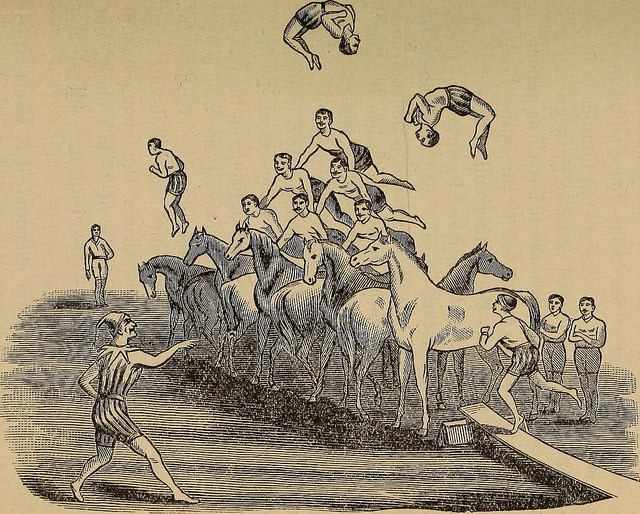 |
| Equestrian Acrobatics | Theatrical and Circus Life (1893) |
The history of the circus goes back thousands of years, with early depictions of acrobats from Egypt from 1300 to 1200 BCE. The Museo Egizio in Turin has an Egyptian wall fragment from this period showing a female acrobat in a backbend, with long, wavy hair flowing to the ground, large, gold hoop earrings, and wearing only a short sarong. Mexican ceramic statuettes from 200 BCE to 500 BCE, and prior periods, show contortionists doing splits. The Mexican statuettes, like a Hellenic Greek statuette depicting an acrobat, have in common a sense of joy and play: the subjects are smiling and theatrical.
Of course most people might recognize the term, “circus,” or the idea of performances taking place in a circular venue when they think of ancient Rome and the gladiator contests and chariot races. Chariot races began the trend of highlighting the horse’s—and his master’s—prowess in a circular arena during a longer period of entertainment by other performers. These Roman gladiator and chariot contests included interludes with juggling, acrobatics, animal baiting, and sometimes people performing intricate religious rites.
Ancient China and Greece each had their own forms of traveling circuses, and medieval Europe had local fairs with performers, as well as hosting traveling performers who included fortune tellers, jesters, dancers, musicians, and tight-rope walkers. The medieval, and Renaissance, European Church denounced performers who walked over tight-ropes and hot coals, people who could drink boiling oil or swallow fire, strongmen, and others performing seemingly miraculous stunts, thinking the performers too arrogant, or unhappy that money which should go to the Church was being spent on frivolous entertainment; sometimes tight-ropes were strung between steeples and performers were banned from entertaining at religious festivals.
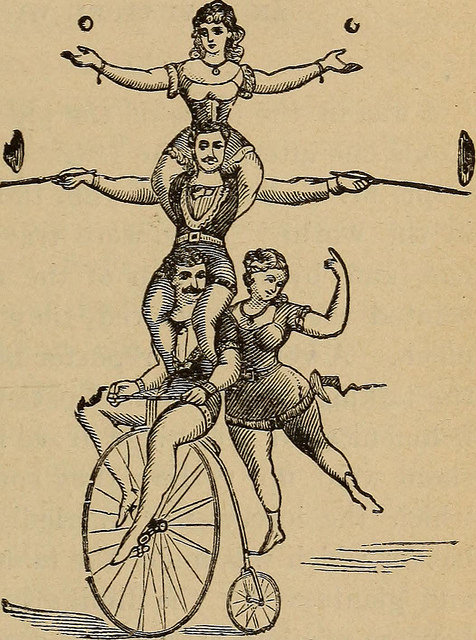 |
| “Bicycle Riding Extraordinary” | Theatrical and Circus Life (1893) |
The modern version of the circus which we know today has its roots in 18th-century Great Britain. Philip Astley (1742-1814), the son of a veneer cutter and cabinetmaker, decided he wanted to be a horseman, since men on horseback were revered at the time as strong and brave, often prior solders. Astley joined the Dragoons cavalry regiment, became a distinguished soldier during the Seven Years War, and left the military in 1766 as sergeant-major. At six feet tall, Astley looked impressive atop a horse and easily started earning a living as a horseman with his white steed, performing trick riding and swordsmanship he had learned in the military. After a few years of traveling to fairs to perform with his horse, he opened a riding school in 1768 close to Westminster Bridge, London, where he trained aristocratic young men and women. After his morning trainings, he entertained to an audience in the school’s amphitheater. He stood and performed acrobatics on his horse, adding ever more balancing tricks, a second horse, and a female equestrienne, Patty, who became his wife; their son John joined the act, as well. He added clowns, magicians, tumblers, and rope dancers. Astley gained competitors, but his was the first “modern” circus, and though the focus was mainly on the horses, he made the other acts integral to the entire spectacle.
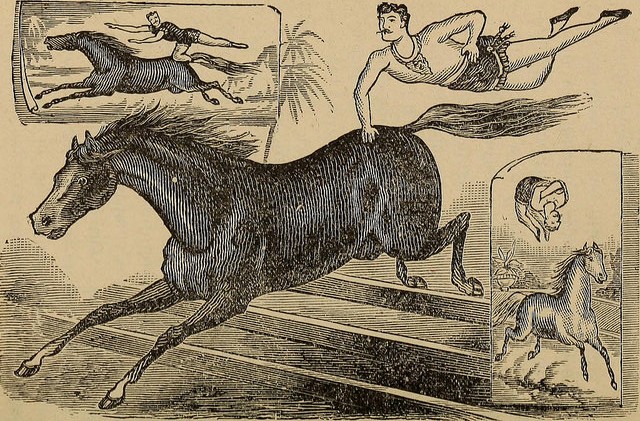 |
| “Bareback Riding” | Theatrical and Circus Life (1893) |
Circuses developed in Europe and America between the 18th and 19thcenturies, with more and more death-defying feats, skimpier outfits on female horse riders and acrobats, and larger-scale performances of plays or poems recreated as stories acted out by performers and horses (and sometimes, elephants). The circus, after Astley’s time, was considered by some critics to be less of an aristocratic affair and more of a degraded mixing of high and low classes in order to see licentious performances. However, people of all social ranks were dazzled by the spectacles and continued to attend the circus. People especially loved women who performed feats on horseback, viewing these women as dominant and yet feminine at the same time, able to control the mighty beast and look dainty while doing so.
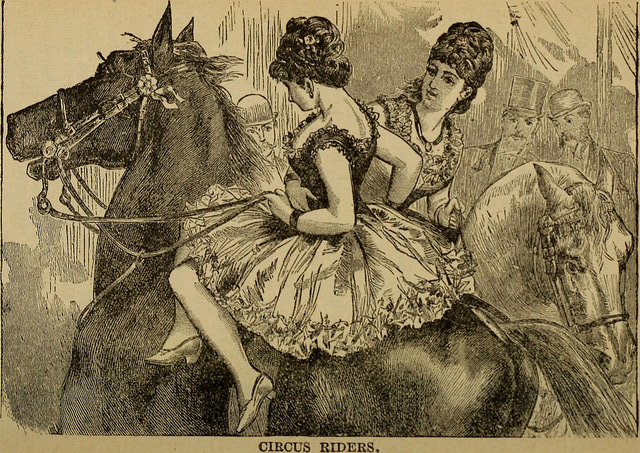 |
| “Circus Riders” | Theatrical and Circus Life (1893) |
The circus had come to represent a close-knit community that offered performers a chance to travel the world, and be praised for their physical feats and appearance. Many children and adults dreamt of “running off to join the circus,” a 19th-century idea that stayed in the public’s imagination through the late 20th-century. (Did you know that when she was a little girl in the 1940s, Jacqueline Bouvier Kennedy Onassis wore a crown when she rode her horse and said she would grow up to be “Queen of the Circus”?)
Phineas Taylor “P.T.” Barnum (1810-1891) was a man of many trades before he became a legendary circus entrepreneur. He had a successful traveling circus, and purchased Scudder’s American Museum in 1841 and renamed it Barnum’s American Museum. It housed sensational curiosities like the fake “Fiji Mermaid”, wax historical figures, relics from the American Revolution, taxidermy specimens, live performers, animals (including hippos, monkeys, snakes, a kangaroo, giraffes, and tigers), and an aquarium with whales. A horrific fire broke out in 1865, tragically killing most of the animals, and destroying most of the objects and exhibitions. Barnum re-opened the Museum at a different location but it burned down once again in 1868, again killing animals and destroying relics, although human performers were saved by firefighters.
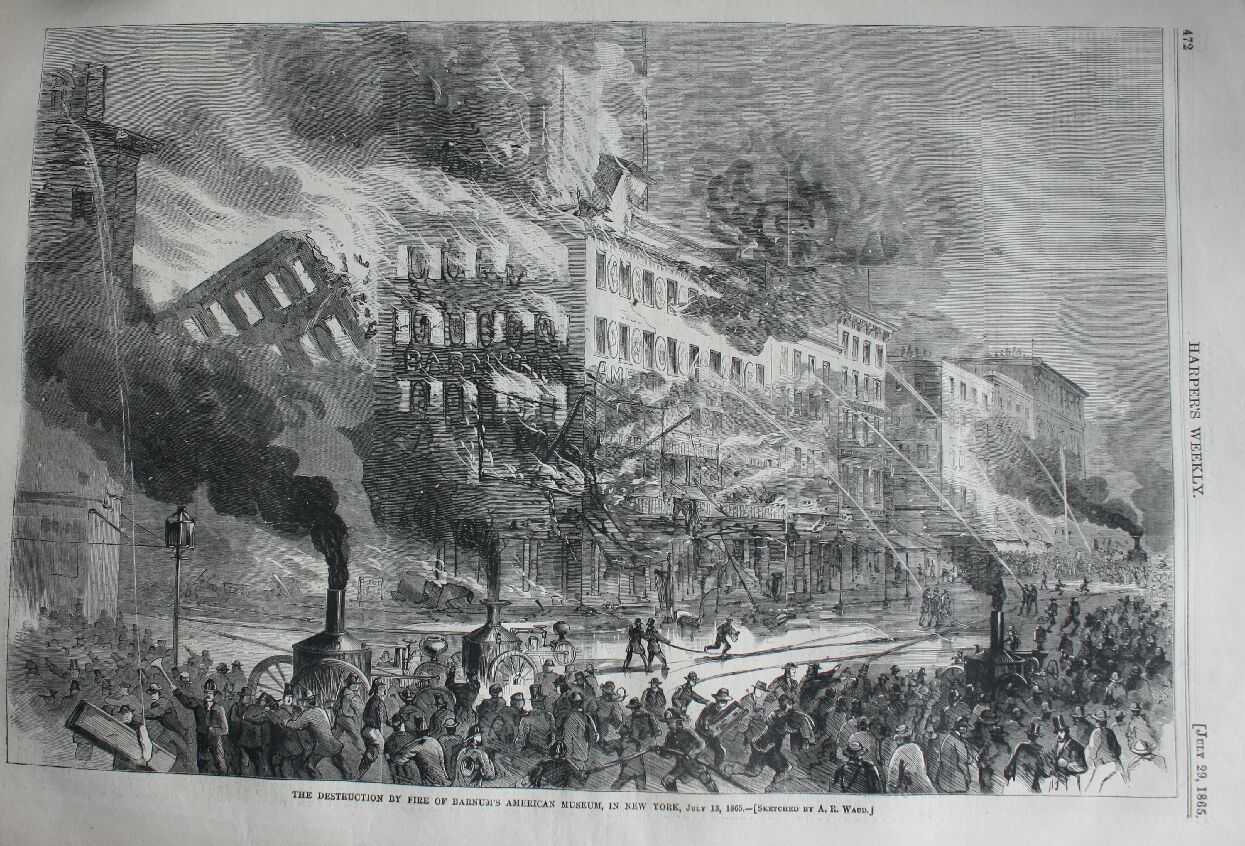 |
| First Fire at Barnum’s American Museum, 1865 | Harper’s Weekly |
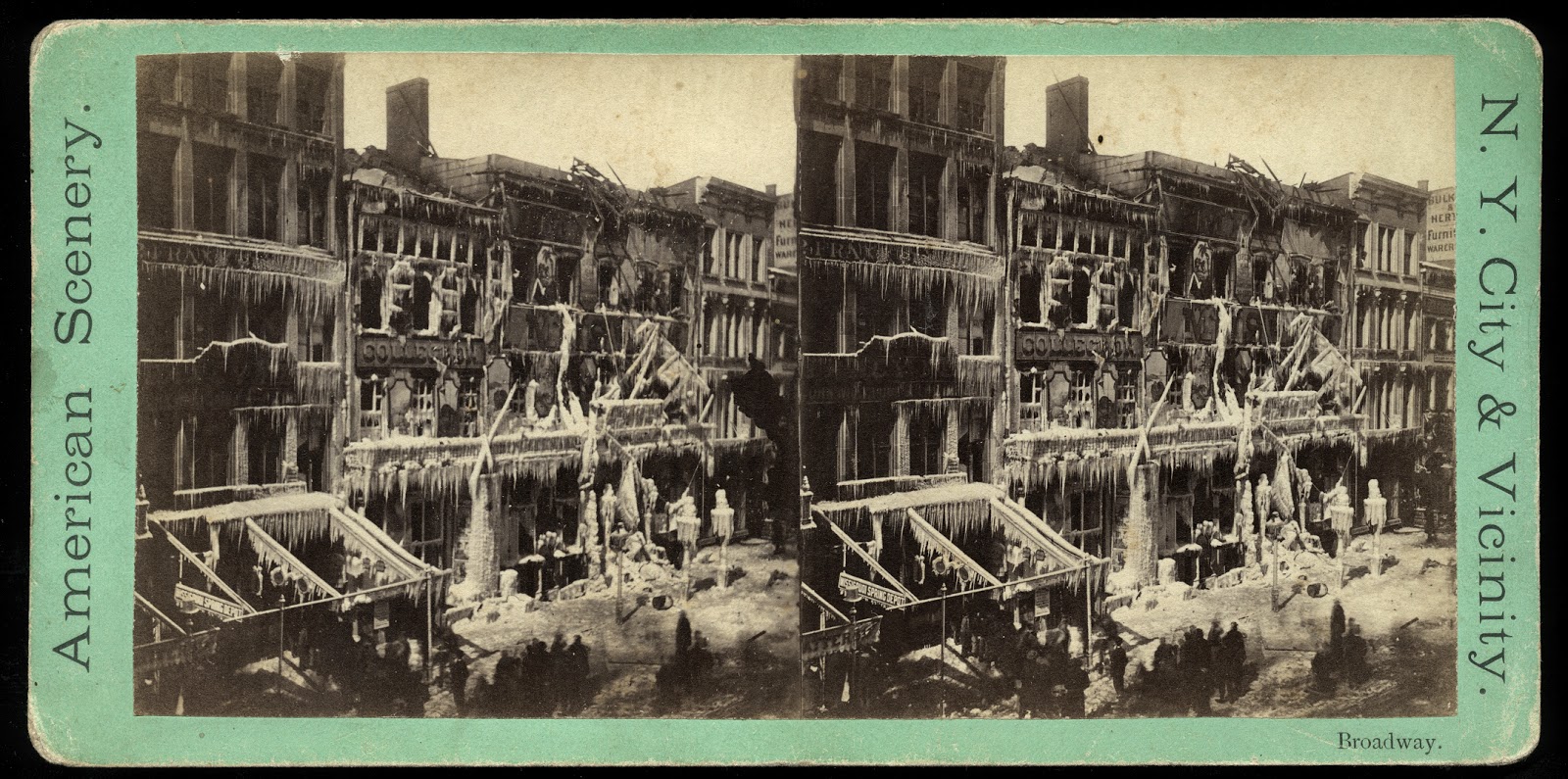 |
| Second Fire at Barnum’s American Museum, 1868 (stereoview image) | Courtesy of Jack Mord, The Thanatos Archive |
After the second American Museum fire, Barnum focused on traveling with his circus, engaging in several partnerships—the most famous, perhaps, with the owner of the very successful Great London Circus, James Anthony Bailey. Bailey was an excellent circus director, and Barnum continued to be in the spotlight as he promoted the circus. By 1889, the Barnum & Bailey Circus was comprised of 1,200 people, and hundreds of horses and animals, and traveled on tour in Europe. When the Circus returned to America in 1903, Barnum & Bailey had serious competitors in the form of the Ringling Brothers. When Barnum died, he left the Circus to Bailey, whose widow, when Bailey died, sold it to the Ringling Brothers. Thus the creation of the “Ringling Brothers Barnum & Bailey Circus,” which still operates today.
While the grand days of the circus died down by the 1950s due to new forms of entertainment, such as Disneyland, there are still active circuses to this day. The circus has always been fraught with the tension of death-defying feats, and the idea of whether it was a moral or immoral concept of entertainment. However, people continue to be dazzled by the magic of spectacle which the circus provides, and has provided, in its many iterations over the years.
Special thanks to Jack Mord (The Thanatos Archive) for special use of the stereoview image of the second fire at Barnum’s American Museum in 1868.
References:
Jennings, J. J. (1893). Theatrical and circus life. . . Chicago: Laird & Lee, Publishers.
Simon, L. (2014). The greatest shows on earth: A history of the circus. London: Reaktion Books.
Sutherland, G. H. (1861). Dr. Sutherland’s system of educating the horse, with rules for teaching the horse some forty different tricks or feats. . . Potsdam, NY: Fay, Baker & Co.’s Steam Power Presses.



Leave a Comment